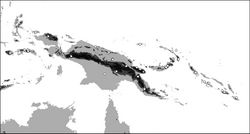Oleandra vulpina
| Notice: | This page is derived from the original publication listed below, whose author(s) should always be credited. Further contributors may edit and improve the content of this page and, consequently, need to be credited as well (see page history). Any assessment of factual correctness requires a careful review of the original article as well as of subsequent contributions.
If you are uncertain whether your planned contribution is correct or not, we suggest that you use the associated discussion page instead of editing the page directly. This page should be cited as follows (rationale):
Citation formats to copy and paste
BibTeX: @article{Hovenkamp2012PhytoKeys11, RIS/ Endnote: TY - JOUR Wikipedia/ Citizendium: <ref name="Hovenkamp2012PhytoKeys11">{{Citation See also the citation download page at the journal. |
Ordo: Polypodiales
Familia: Oleandraceae
Genus: Oleandra
Name
Oleandra vulpina Hovenkamp & Ho, 2012 – Wikispecies link – Pensoft Profile
- Oleandra vulpina C.Chr., Dansk Bot. Ark. 9 68. 1937. Type. PAPUA NEW GUINEA. New Guinea: Ledermann 7652 (holotype: BM).
Description
Rhizome long-creeping, ca. 3 mm thick, not white waxy, sparsely branching, roots with unbranched parts; in cross-section with weakly developed sclerified shealth and few scattered sclerenchyma strands, phyllopodia scattered, 3–6 cm distant, 6–7 mm long. Scales scattered, not covering the rhizome, peltate, to 5 × 0.5 mm, appressed at the base, with a narrow squarrose acumen, dark brown near attachment, lighter towards margin, margin densely set with glands and multicellular hairs terminating in a gland. Fronds monomorphic; stipes with scales as the rhizome but less dense and with short fine glandular hairs; stipe 2–3 mm long, without dark coloration on abaxial side, bearing short fine glandular hairs; lamina linear-lanceolate, 17.5—20 × 3–4 cm wide, base cuneate, apex short caudate, tips up to 1 cm long, margin undulate, weakly cartilaginous, texture papyraceous, all parts with to 0.5 mm long catenate glandular hairs, or with longer, to 1.5 mm, acicular hairs; costa abaxially without dark coloration, with hairs like the stipe and with small scales; veins terminating in a weakly developed hydathode before the margin. Sporangial stalk with glands below the sporangium. Sori in an irregular row 2.5–6 mm from the costa, indusium round-reniform, c. 0.5 mm across, fugacious at very early stage. Spores absent.
Distribution
New Guinea, at 975 m.
Ecology
Scandent on trunk of Sago palm in garden, or in forest.
Vernacular name
Taingelem (Wapi language, Miwaute)
Discussion
Oleandra vulpina is distinct from Oleandra sibbaldii in the rhizome and costa scales. Rhizome scales are darker in colour with pale-coloured margin, long subulate apices, and margin strongly ciliate with glandular hairs. A similar glandular scale indument is found in the American Oleandra articulata (Sw). C. Presl, but not in the other Southeast Asian species. The costa scales beneath are small and inconspicuous, narrowly lanceolate. In addition, the rhizome of Oleandra vulpina is not glaucous. The indusia are very small and shrivel at a very young stage but are distinct when present and bear numerous setose hairs.
Taxon Treatment
- Hovenkamp, P; Ho, B; 2012: A revision of the fern genus Oleandra (Oleandraceae) in Asia PhytoKeys, 11: 1-37. doi
Images
|
